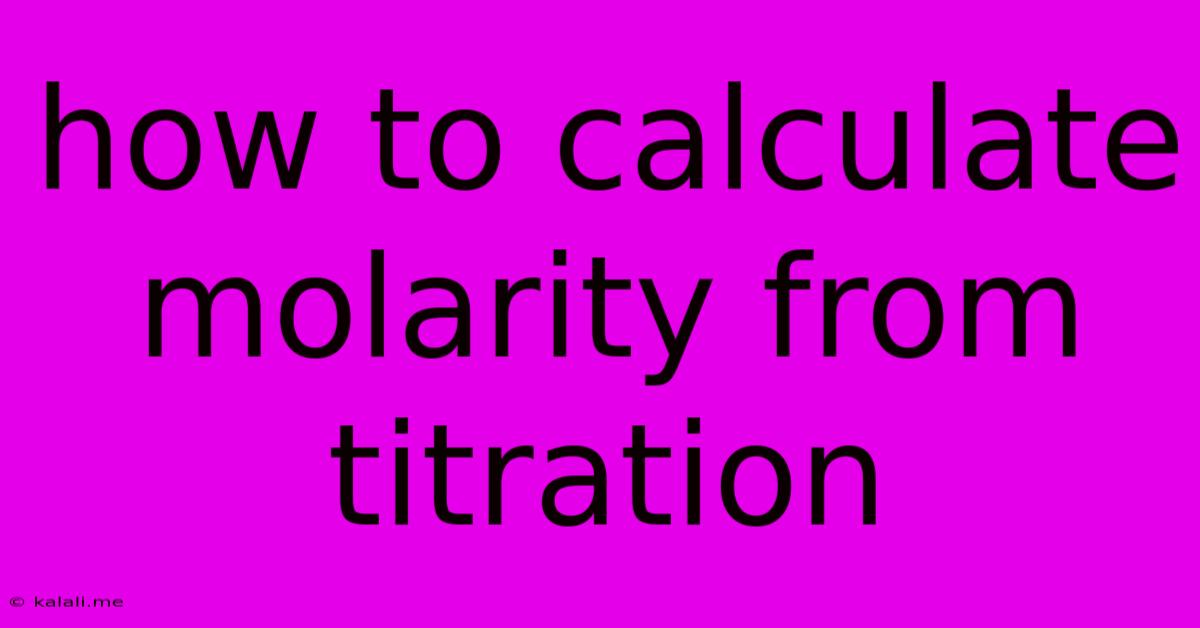How To Calculate Molarity From Titration
Kalali
May 09, 2025 · 4 min read

Table of Contents
How to Calculate Molarity from Titration: A Step-by-Step Guide
Meta Description: Learn how to accurately calculate molarity from titration data. This comprehensive guide covers the essential steps, formulas, and considerations for precise results. Master the concepts of stoichiometry and molarity calculations in titrations.
Titration is a fundamental technique in chemistry used to determine the concentration of an unknown solution (analyte) by reacting it with a solution of known concentration (titrant). The point at which the reaction is complete is called the equivalence point, and its determination allows us to calculate the molarity of the unknown solution. This guide will walk you through the process step-by-step.
Understanding the Concepts
Before diving into the calculations, let's refresh some key concepts:
- Molarity (M): This represents the concentration of a solution, expressed as moles of solute per liter of solution (mol/L).
- Equivalence Point: The point in a titration where the moles of titrant added are stoichiometrically equal to the moles of analyte present.
- Stoichiometry: The quantitative relationship between reactants and products in a chemical reaction, crucial for accurate molarity calculations.
- Balanced Chemical Equation: Absolutely essential! It provides the mole ratio between the titrant and analyte, which is the key to the calculation.
Step-by-Step Calculation of Molarity from Titration Data
Let's assume we're titrating a solution of unknown concentration of an acid (analyte) with a base of known molarity (titrant). Here's how to calculate the molarity of the acid:
1. Gather your Data:
- Volume of analyte (V<sub>analyte</sub>): This is the volume of the unknown solution you titrated, usually measured in milliliters (mL). Remember to convert to liters (L) for molarity calculations.
- Molarity of titrant (M<sub>titrant</sub>): This is the known concentration of the solution you used to titrate, in moles per liter (mol/L).
- Volume of titrant used (V<sub>titrant</sub>): This is the volume of the titrant required to reach the equivalence point, also usually measured in milliliters (mL). Convert to liters (L).
- Balanced Chemical Equation: This equation is essential to determine the stoichiometric ratio between the acid and base. For example, a simple acid-base reaction might be: HCl(aq) + NaOH(aq) → NaCl(aq) + H₂O(l) In this case, the mole ratio between HCl and NaOH is 1:1.
2. Calculate Moles of Titrant:
Use the formula: Moles of titrant = M<sub>titrant</sub> × V<sub>titrant</sub> (in Liters)
3. Determine the Mole Ratio from the Balanced Equation:
Using the balanced chemical equation, identify the stoichiometric mole ratio between the titrant and analyte. This ratio will be crucial in the next step. For the example above (HCl and NaOH), the mole ratio is 1:1.
4. Calculate Moles of Analyte:
Use the mole ratio from step 3 to calculate the moles of analyte:
Moles of analyte = (Moles of titrant) × (Mole ratio of analyte to titrant)
5. Calculate Molarity of Analyte:
Finally, calculate the molarity of the analyte using the formula:
M<sub>analyte</sub> = Moles of analyte / V<sub>analyte</sub> (in Liters)
Example Calculation
Let's say we titrated 25.00 mL of an unknown HCl solution with 0.100 M NaOH. It took 20.00 mL of NaOH to reach the equivalence point. The balanced equation is HCl(aq) + NaOH(aq) → NaCl(aq) + H₂O(l).
-
Data: V<sub>analyte</sub> = 25.00 mL = 0.02500 L; M<sub>titrant</sub> = 0.100 M; V<sub>titrant</sub> = 20.00 mL = 0.02000 L; Mole ratio = 1:1
-
Moles of titrant: Moles of NaOH = 0.100 M × 0.02000 L = 0.00200 moles
-
Mole Ratio: 1:1 (from the balanced equation)
-
Moles of analyte: Moles of HCl = 0.00200 moles × 1 = 0.00200 moles
-
Molarity of analyte: M<sub>analyte</sub> = 0.00200 moles / 0.02500 L = 0.0800 M
Therefore, the molarity of the HCl solution is 0.0800 M.
Important Considerations
- Accurate Measurements: Precise measurements of volumes are crucial for accurate results. Use calibrated glassware and appropriate techniques.
- Endpoint vs. Equivalence Point: The endpoint (observed color change) is an approximation of the equivalence point. Choosing the right indicator is essential to minimize error.
- Error Analysis: Consider potential sources of error, such as indicator choice, reading volumes, and temperature fluctuations.
By following these steps and understanding the underlying principles, you can confidently calculate molarity from titration data, a skill essential in many areas of chemistry. Remember to always double-check your calculations and consider potential sources of error.
Latest Posts
Latest Posts
-
What Is The Charge Of K
May 09, 2025
-
11 Over 5 As A Mixed Number
May 09, 2025
-
A Rectangular Prism Has How Many Edges
May 09, 2025
-
90 Is What Percent Of 60
May 09, 2025
-
Which Algebraic Expressions Are Polynomials Check All That Apply
May 09, 2025
Related Post
Thank you for visiting our website which covers about How To Calculate Molarity From Titration . We hope the information provided has been useful to you. Feel free to contact us if you have any questions or need further assistance. See you next time and don't miss to bookmark.